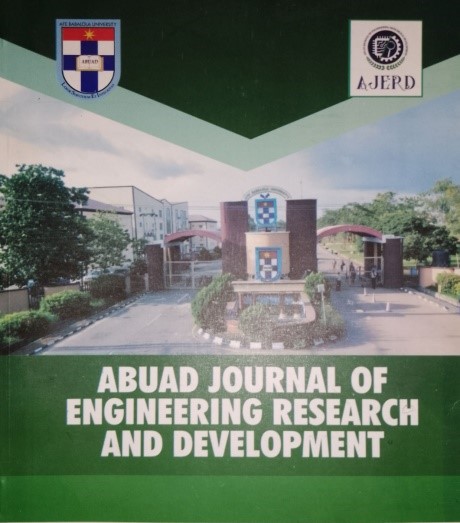Semi Empirical Modelling of Alkaline Water Electrolysis Green Hydrogen Using Biosynthesized Lye and Caustic Soda Electrolytes
Main Article Content
Abstract
Semi empirical modelling of an alkaline water electrolysis system for green hydrogen production was carried out in this paper. Green hydrogen which is an alternative to fossil fuels and other sources of energy because of its renewability and sustainability is produced via alkaline water electrolysis utilizing biosynthesized lye (KOH) and caustic soda (NaOH) obtained from charring unripe plantain peel and electrolysing sea water respectively. The alkaline water electrolysis process was carried out at electrolyte concentrations of 25 g/L, 30 g/L and 35g/L for KOH and NaOH, at temperatures 45 oC, 55 oC, 65 oC, 75 oC and 85 oC, applying a voltage of 9 volts and running the electrolytic process for 15 minutes to obtain the volume of hydrogen generated at the cathode. The models developed were for the cell voltage of the energy consumed, the Faraday’s efficiency of the alkaline water electrolysis and the gas purity of the hydrogen produced. All R2 values which represent the coefficient of determination were within the range of 0.96-0.999, indicating that the semi empirical models were a good fit to represent the alkaline water electrolysis, with the exception with the cell voltage models at 30 g/L of KOH and 30 g/L NaOH which had an R2 values of 0.7826 and 0.782 respectively. Also, a pop and combustion test was carried out to determine the presence and flammability of hydrogen at the cathode of the electrolytic cell.
Downloads
Article Details

This work is licensed under a Creative Commons Attribution-NonCommercial-ShareAlike 4.0 International License.
References
Martins, F., Felgueiras, C., Smitkova, M.F., & Caetano, N.S. (2019). Analysis of Fossil Fuel Energy Consumption and Environmental Impacts in European Countries, Energies, 12(6): 964-973. https://doi.org/10.3390/en12060964.
Wang, M., Wang, G., Sun, Z., Zhang, Y., & Xu, D. (2019). Review of renewable energy-based hydrogen production processes for sustainable energy innovation, Global Energy Interconnection, 2(5): 436-443. https://doi.org/10.1016/j.gloei.2019.11.019
ul Husnain, M.I., Syed, Q.R., Bashir, A., & Khan, M.A. (2022). Do geopolitical risk and energy consumption contribute to environmental degradation? Evidence from E7 countries, Environmental Science and Pollution Research International, 29(27): 41640–41652. https://doi.org/10.1007/s11356-021-17606-z.
Crabtree, G.W & Dresselhaus, M.S. (2008). The hydrogen fuel alternative, MRS Bulletin, 33(4): 421–428. https://doi.org/10.1557/mrs2008.84.
Nicoletti, G., Arcuri, N., Nicoletti, G., & Bruno, R. (2015). A technical and environmental comparison between hydrogen and some fossil fuels, Energy Conversion and Management, 89: 205–213. https://doi.org/10.1016/j.enconman.2014.09.057.
Saha, P., Akash, F.A., Shovon, S.M., Monir, M.U., Ahmed, M.T., Khan, M.F.H., Sarkar, S.M., Islam, M.K., Hasan, M.M., Vo, D.V.N., & Aziz, A.A. (2023). Grey, blue, and green hydrogen: A comprehensive review of production methods and prospects for zero-emission energy, International Journal of Green Energy, 1-15. https://doi.org/10.1080/15435075.2023.2244583.
Brauns, J & Turek, T. (2020), Alkaline water electrolysis Powered by Renewable Energy: a review, Processes, 8(2): 248. https://doi.org/10.3390/pr8020248.
Enontiemonria, E.V., Abiodun, O.J., & Eric, K.E. (2016). Extraction and use of potassium hydroxide from ripe plantain peels ash for biodiesel production, Journal of Biobased Materials and Bioenergy, 10(1): 1-9. https://doi.org/10.1166/jbmb.2016.1567.
Hou, M., Chen, L., Guo, Z., Dong, X., Wang, Y., & Xia, Y. (2018). A clean and membrane-free chlor-alkali process with decoupled Cl2 and H2/NaOH production, Nature communications, 9(1): 438. https://doi.org/10.1038/s41467-018-02877-x
Ofori, P., & Awudza, J.A. (2017). Production of potassium hydroxide (KOH) from plant biomass: the case of cocoa pod husks and plantain peels, Kwame Nkrumah University of Science and Technology, Kumasi.
Ulleberg, O. (2003). Modelling of advanced alkaline electrolyzer: a system simulation approach, International Journal of Hydrogen Energy, 28(1): 21-33. https://doi.org/10.1016/S0360- 3199(02)00033-2.
Diéguez, P.M., Ursúa, A., Sanchis, P., Sopena, C., Guelbenzu, E., & Gandía, L.M. (2008). Thermal performance of a commercial alkaline water electrolyzer: Experimental study and mathematical modelling, International journal of hydrogen energy, 33(24):7338-7354. https://doi.org/10.1016/j.ijhydene.2008.09.051.
Sanchez, M., Amores, E., Rodriguez, L., & Clemente-Jul, C. (2018). Semi-empirical model and Experimental Validation for the Performance Evaluation of a 15kW Alkaline Water Electrolyzer, International Journal of Hydrogen energy, 43(45): 20332-20345. https://doi.org/10.1016/j.ijhydene.2018.09.029.
Bessarabov, D., Wang, H., Li, H & Zhao, N. (2016). PEM electrolysis for hydrogen production: principles and applications. CRC press.
Sellami, M.H., & Loudiyi, K. (2017). Electrolytes behavior during hydrogen production by solar energy, Renewable & Sustainable Energy Reviews, 70: 1331–1335. https://doi.org/10.1016/j.rser.2016.12.034
Hug, W., Bussmann, H., & Brinner, A. (1993). Intermittent operation and operation modelling of an alkaline electrolyser, International journal of hydrogen energy, 18(12): 973-977. https://doi.org/10.1016/0360-3199(93)90078-O.
Haug, P., Koj, M., & Turek, T. (2017). Influence of process conditions on gas purity in alkaline water electrolysis, International Journal of Hydrogen Energy, 42(15): 9406-9418. https://doi.org/10.1016/j.ijhydene.2016.12.111.
Gilliam, R.J., Graydon, J.W., Kirk, D.W., & Thorpe, S.J. (2007). A review of specific conductivities of potassium hydroxide solutions for various concentrations and temperatures, International Journal of Hydrogen Energy, 32(3): 359–364. https://doi.org/10.1016/j.ijhydene.2006.10.062.
Yuvaraj, A.L., & Santhanaraj, D. (2013). A systematic study on electrolytic production of hydrogen gas by using graphite as electrode, Materials Research,17(1): 83–87. https://doi.org/10.1590/S1516-14392013005000153.
Shen, M., Bennett, N., Ding Y., & Scott, K. (2011). A concise model for evaluating water electrolysis, International Journal of Hydrogen Energy,36(3): 14335–14341. https://doi.org/10.1016/j.ijhydene.2010.12.029.




